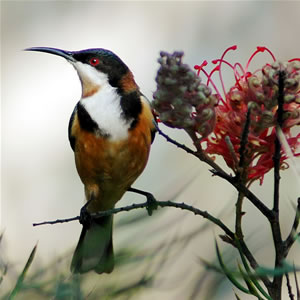- Eastern Spinebill
Taxobox
name = Eastern Spinebill
status = LC | status_system = IUCN3.1
status_ref= [IUCN2006|assessors=BirdLife International|year=2004|id=50831|title=Acanthorhynchus tenuirostris|downloaded=12 May 2006]
image_width = 250px

regnum =Animal ia
phylum = Chordata
classis = Aves
ordo =Passeriformes
familia = Meliphagidae
genus = "Acanthorhynchus"
species = "A. tenuirostris"
binomial = "Acanthorhynchus tenuirostris"
binomial_authority = (Latham, 1802)The Eastern Spinebill, "Acanthorhynchus tenuirostris", is a species of
honeyeater found in south-easternAustralia in forest and woodland areas, as well as gardens in urban areas of Sydney and Melbourne. It is around 15 cm long, and has a distinctive black, white and chestnut plumage, a red eye, and a long downcurved bill.Taxonomy
Originally described as "
Certhia tenuirostris" by ornithologist John Latham in 1802, [Latham, J. (1802). "Supplementum Indicis Ornithologici, sive Systematis Ornithologiae." London: G. Leigh, J. & S. Sotheby 74 pp. [36}] it is a member of the small genus "Acanthorhynchus " with one other, theWestern Spinebill ofWestern Australia . The generic name is derived from the Greek translation of its common name, namely "acantho-"/ακανθο- "spine" and "rhynchos"/ρυνχος "bill".cite book | author = Liddell, Henry George and Robert Scott | year = 1980 | title =A Greek-English Lexicon (Abridged Edition) | publisher =Oxford University Press | location = United Kingdom | isbn= 0-19-910207-4] Its specific name is fromLatin "tenuis" "narrow" and "rostrum" billed. It belongs to thehoneyeater family Meliphagidae. More recently,DNA analysis has shown honeyeaters to be related to thePardalotidae , and thePetroicidae (Australian robins) in a large corvid superfamily; some researchers considering all these families in a broadly definedCorvidae .Description
13-16 cm (5-6 in) long, the male Eastern Spinebill has a long thin downcurved black bill with a black head, white throat with a reddish patch and red iris. It has a brownish-red nape, a grey brown back and pale cinnamon underparts. The dark tail is tipped with white laterally. Females and juveniles are smaller and duller. The call is a rapid piping. [cite book | author = Simpson K, Day N, Trusler P | title = Field Guide to the Birds of Australia | publisher = Viking O'Neil | date = 1993 | location = Ringwood, Victoria | pages = 392 | id = ISBN 0-670-90478-3]
Distribution and habitat
Eastern Spinebills are found in dry
sclerophyll forest, scrub and heathland from theCooktown area in North Queensland south through New South Wales east of theGreat Dividing Range , through Victoria and into theFlinders Ranges in eastern South Australia as well as throughoutTasmania . Adaptable, they can be found in urban gardens with sufficient vegetation to act as cover and a food source.Reproduction
Breeding season is from August to December, with one or two broods raised. The nest is a deep cup-shaped structure of grass and bark lined with feathers, generally in the fork of a small bushy tree or shrub. The clutch is 2-3 pinkish eggs with dark reddish brown blotches and spots 17 x 13 mm in size. [cite book | last = Beruldsen | first = G | title = Australian Birds: Their Nests and Eggs | publisher = self | date = 2003 | location = Kenmore Hills, Qld | pages = 327 | doi = | id = ISBN 0-646-42798-9]
Diet
The Eastern Spinebill feeds on nectar from many plants, including the blooms of gum trees, mistletoes "
Amyema " spp., "Epacris longiflora ", "Epacris impressa ", "Correa reflexa ", and various members of theProteaceae such as "Banksia ericifolia ",cite journal |last=Paton |first=D.C. |coauthors=V. Turner |year=1985 |title=Pollination of "Banksia ericifolia" Smith: Birds, mammals and insects as pollen vectors |journal=Australian Journal of Botany |volume=33 |issue=3 |pages= 271–286 |doi=10.1071/BT9850271] "Banksia integrifolia ", "Lambertia formosa " and "Grevillea speciosa ", as well as small insects and other invertebrates. A 1982 study in theNew England National Park in North-easternNew South Wales found that there was a large influx of birds coinciding with the start of flowering of "Banksia spinulosa " there.Ford HA & Pursey JF. (1982)Status and feeding of the Eastern Spinebill "Acanthorhynchus tenuirostris" at the New England National Park, North-eastern NSW. "Emu" 82(4) 203 - 211] They have been known to feed from exotic plants such asFuchsia s. [cite web | authorlink = Australian Museum | author = Australian Museum | title = Bird Finder - Eastern Spinebill | work = Birds in Backyards | publisher = Australian Museum | date = 2006 | url = http://birdsinbackyards.net/finder/display.cfm?id=109 | accessdate = 2007-06-26]References
Wikimedia Foundation. 2010.
